General
What Is UX Writing? A Comprehensive Overview of Its Principles and Practices
Overview
UX writing represents a specialized discipline dedicated to crafting clear, concise, and user-centric text that significantly enhances the user experience within digital products. Effective UX writing is underpinned by fundamental principles such as:
- Clarity
- Brevity
- Empathy
These principles are not merely guidelines; they are essential for steering users through their interactions, ensuring satisfaction, and ultimately fostering positive impacts on engagement and conversion rates.
Introduction
In the digital age, where user experience dictates the success of products, UX writing emerges as a vital discipline that shapes how users interact with technology. This nuanced field encompasses everything from button labels to error messages, all crafted with the intent to enhance clarity and engagement. As trends evolve, the importance of personalization and context-aware communication becomes increasingly evident. Statistics reveal that tailored messaging can dramatically boost user interaction.
With a profound impact on user satisfaction and brand loyalty, effective UX writing transcends mere words displayed on a screen; it embodies a strategic approach that intertwines empathy, brevity, and clarity to create seamless digital experiences. As organizations recognize the critical role of UX writers within design teams, understanding the principles and practices of this discipline is essential for anyone looking to navigate the complexities of modern digital communication.
Defining UX Writing: An Introduction to Its Core Concepts
UX composition is a critical discipline that defines what UX writing entails, focusing on the creation of text encountered by users while interacting with digital products, including websites and applications. This practice encompasses a broad spectrum of elements, from button labels and error messages to onboarding instructions and help content. The essence of UX writing is to enhance user experience by ensuring that the language is clear, concise, and tailored to user needs.
In 2025, prevailing trends in UX writing underscore the importance of personalization and context-awareness, which are vital for effectively engaging users. For instance, customizing push notifications can boost response rates by as much as 400%, illustrating the power of personalized communication in enhancing user interaction. Furthermore, statistics indicate that 88% of users are less likely to return to a site after experiencing poor UX, while 91% of dissatisfied customers tend to leave without providing feedback.
These statistics highlight the necessity of investing in UX design, as it can prevent significant costs related to redesigns and customer attrition. Indeed, investing in UX design can yield long-term savings by minimizing the need for expensive redesigns.
At its core, UX writing involves several fundamental concepts, such as clarity, brevity, and user-centricity. A comprehensive understanding of UX writing is essential, as it not only guides users through their journey but also enhances their overall satisfaction and engagement with the product. For example, a strategic campaign for Quaker Oats executed by WonderEight demonstrated how effective UX communication can elevate brand presence and foster consumer loyalty in a competitive landscape.
Specific UX communication strategies, including clear messaging and intuitive navigation, were instrumental in the campaign’s success, exemplifying the direct impact of effective UX communication on brand engagement.
Expert opinions affirm that UX writing is crucial for effective communication within digital products, as it significantly influences user perception and interaction. By focusing on essential elements such as tone, consistency, and accessibility, UX writers can create a seamless experience that resonates with users. Notably, only 68% of internet users aged 18-29 express high confidence in using digital devices to complete online tasks, underscoring the challenges they face and the vital role of effective UX communication in addressing these issues.
Examples of successful UX communication are evident in leading websites and applications, where clear instructions and intuitive language markedly enhance user engagement.
In conclusion, grasping the concept of UX writing is paramount; it transcends mere words on a screen and represents a foundational aspect of digital product design that shapes user experiences and drives satisfaction. As the digital landscape evolves, the significance of UX writing will continue to be pivotal in crafting engaging and user-friendly products.
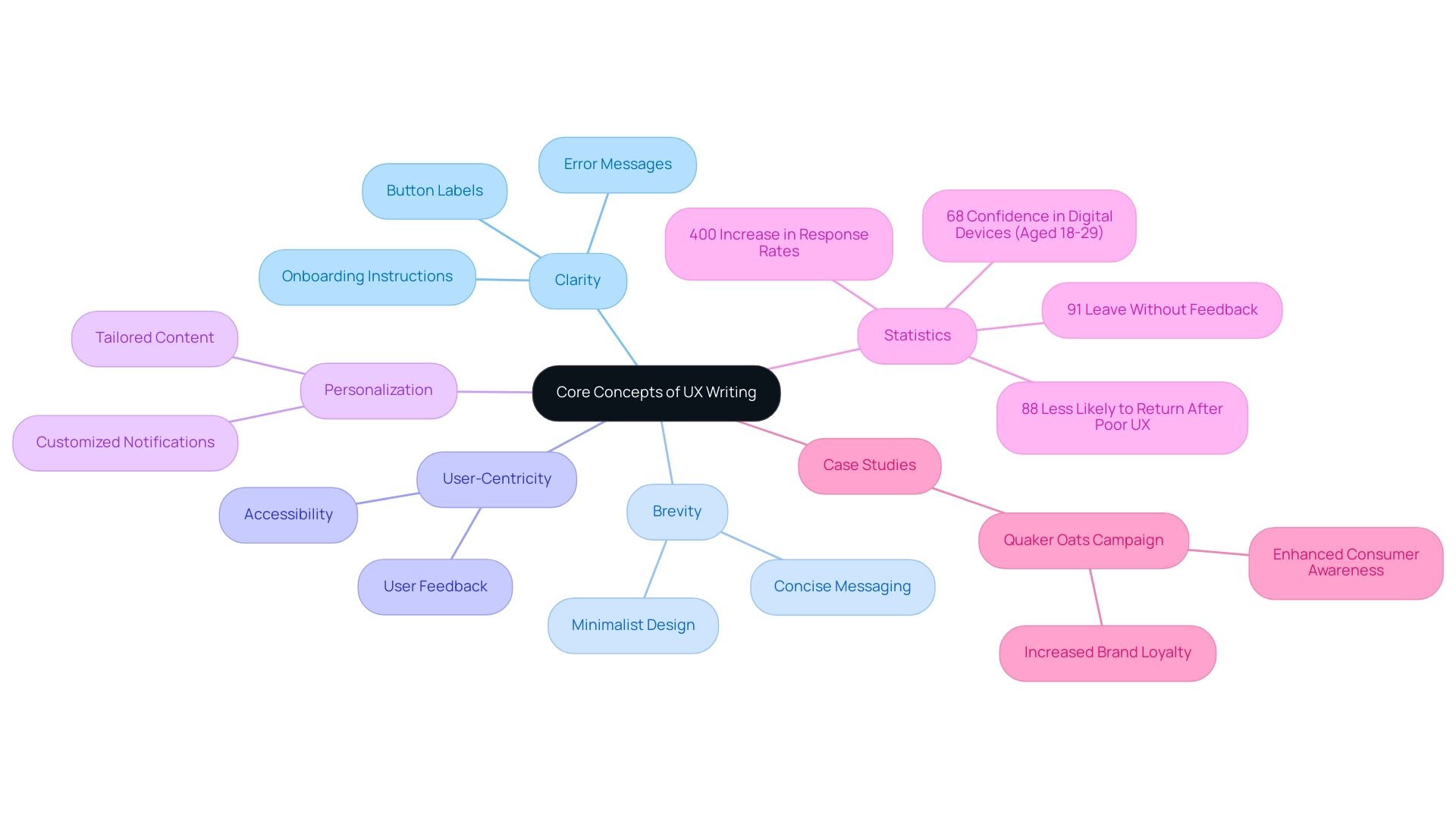
The Role of a UX Writer: Responsibilities and Impact on Design Teams
A UX author plays a pivotal role within the design group, tasked with creating and refining the textual content that guides users through digital products. Their responsibilities extend far beyond simple content creation; they engage in close collaboration with designers, product managers, and developers to ensure that the language employed aligns seamlessly with overarching design and experience goals. Through comprehensive audience research, UX authors acquire valuable insights into target needs and preferences, allowing them to craft messages that resonate effectively with users.
The influence of UX writing on audience experience is profound. By emphasizing clarity and usability, UX professionals significantly mitigate user frustration and enhance product accessibility. Statistics reveal that a mere 0.1-second enhancement in web page speed correlates with increased sales, views, average order value, and conversion rates, highlighting the critical nature of effective communication in digital contexts.
Moreover, research indicates that investing in customer experience yields substantial financial returns, with every dollar spent generating an average return of 100 dollars. Notably, leading companies in user experience have outperformed the S&P 500 index by 35%, underscoring the essential role that UX professionals play in driving product success.
Case studies illustrate the collaborative efforts of UX professionals within design teams. Successful projects frequently demonstrate how UX contributors enhance product usability, resulting in increased conversion rates. In fact, effective UI can elevate conversion rates by up to 200%, while proficient UX can double this figure, showcasing the tangible benefits of integrating skilled UX writing into product design.
Findings from Forrester’s case study titled “Return on Investment in UX” further reinforce this perspective, indicating that prudent UX investments can lead to significant financial gains.
In summary, comprehending what UX writing entails involves recognizing the responsibilities of a UX writer, which encompass not only the creation of user-centric material but also the enhancement of overall product design. Their expertise in understanding client behavior and preferences is crucial for crafting engaging experiences that ultimately foster greater satisfaction and business success. As Ramziya Muhammed, a content marketer at WowMakers, aptly states, “Understanding audience behavior and preferences is crucial to designing effective and engaging experiences.”
This insight underscores the significance of UX professionals in the design process, particularly in agencies like WonderEight, which distinguish themselves by merging creativity with technology.
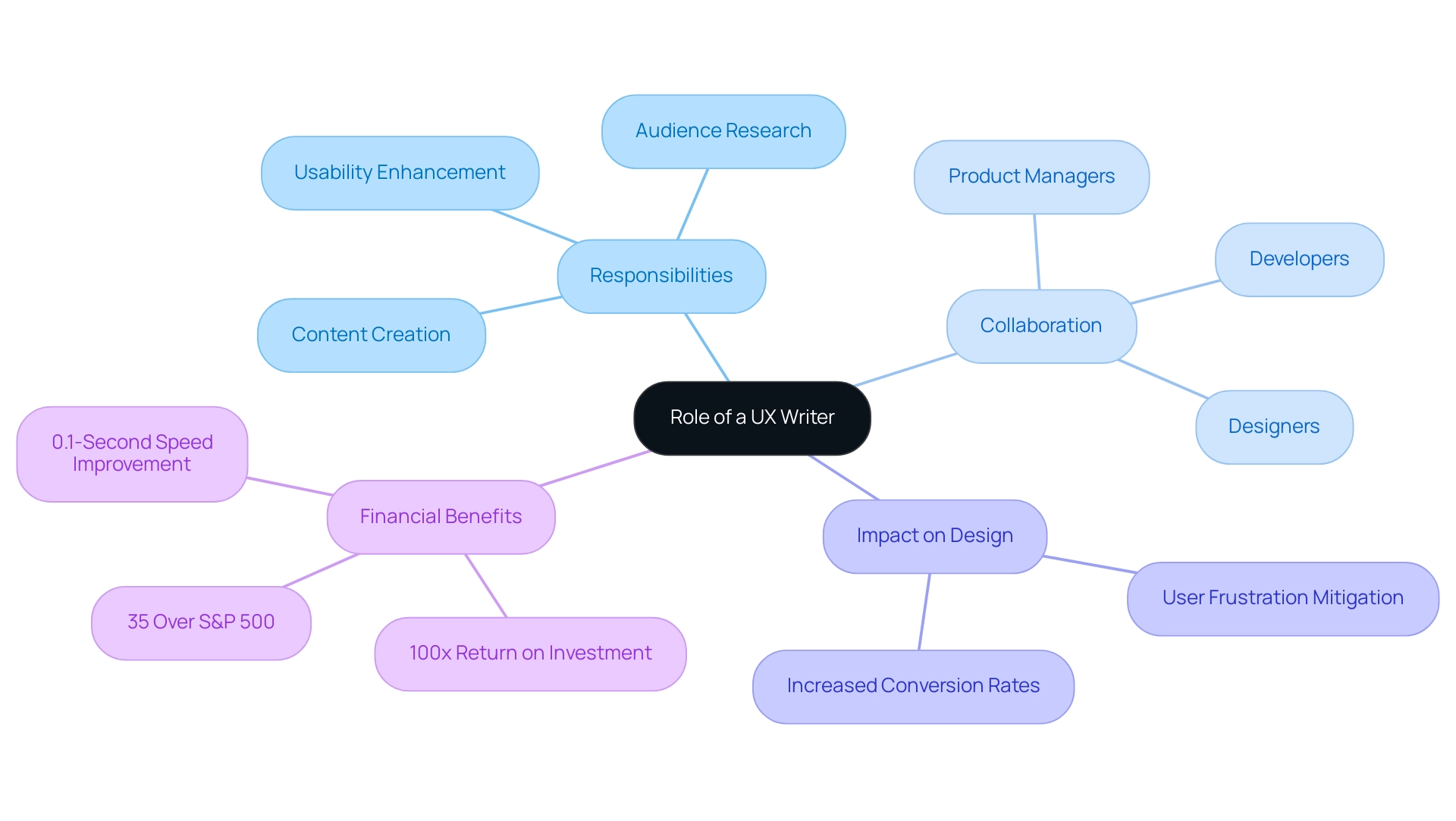
Key Skills for UX Writers: What You Need to Succeed
Essential abilities for effective UX professionals encompass a blend of robust writing and editing skills, a profound understanding of experience principles, and a high degree of empathy. These professionals excel at distilling complex information into clear, accessible language that resonates with a diverse audience. Familiarity with design tools and user research methodologies further enhances their effectiveness, enabling them to produce material that aligns seamlessly with user needs and design objectives.
Effective communication and collaboration are paramount, as UX writers frequently engage with cross-functional teams, ensuring that strategies are integrated into the overall design process. The demand for these skills is increasingly reflected in the job market, where companies actively seek professionals capable of bridging the gap between technical design and user-friendly content. An upcoming course starting on 1 April 2025, costing €4,750, underscores the growing interest in cultivating these essential skills.
Case studies, such as the comprehensive campaign executed for Quaker Oats, vividly illustrate the impact of effective UX communication. This campaign revitalized the brand’s image and fostered a deeper connection with modern consumers, showcasing how strategic messaging can enhance brand perception and loyalty. Additionally, the brand identity uplift for Castania highlights the measurable outcomes achievable through thoughtful UX communication.
As we look toward 2025, understanding what UX writing entails and the importance of empathy within it becomes essential. Grasping the essence of UX writing allows authors to comprehend individuals’ emotions and experiences, enabling them to craft messages that guide people smoothly through their interactions. As Cynthia Vinney, a contributor for the UX Design Institute, aptly observes, “the UX author has crafted the messaging to be clear, accessible, and straightforward, enabling individuals to comfortably navigate through the process.”
This empathetic approach, combined with the essential skills outlined, positions UX writers as vital contributors to successful product teams.
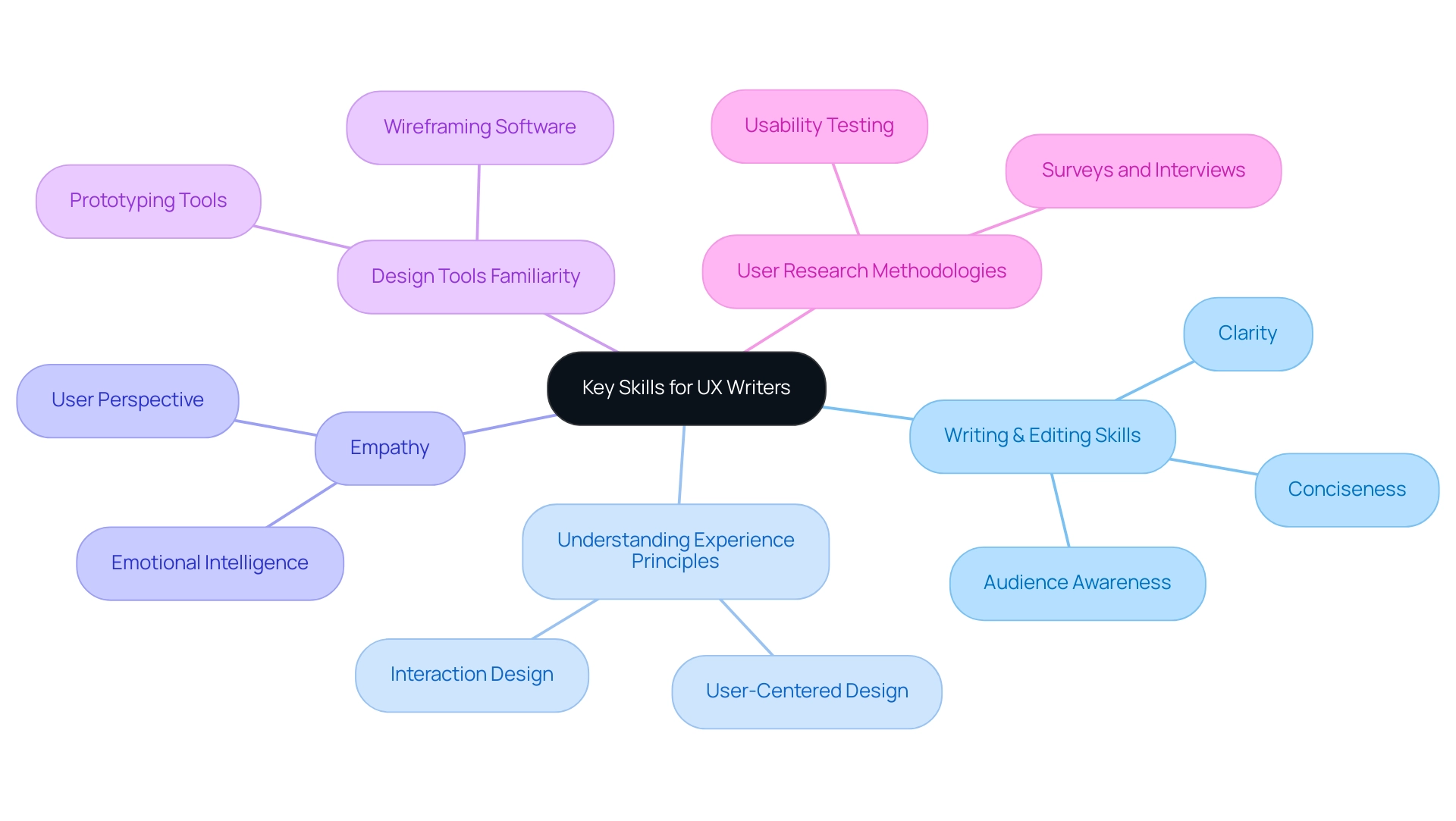
UX Writing vs. Other Writing Disciplines: Understanding the Differences
UX content distinguishes itself from copy and technical writing through its unique focus on enhancing user experience. While copywriting primarily aims to persuade and drive sales, UX text prioritizes clarity and guidance, ensuring users can navigate products intuitively. In contrast, technical documentation deals with complex information and processes, making it vital for conveying detailed instructions or specifications.
At its core, UX composition emphasizes the individual’s journey, striving to facilitate a seamless interaction with the product.
Understanding what UX writing entails and recognizing these distinctions is crucial for authors looking to carve out their niche in the industry. For example, a simple wording adjustment—altering ‘Book a Room’ to ‘Check Availability’—has been demonstrated to increase traffic and engagement by 17%. This underscores the significant impact that precise UX content can have on user behavior.
Furthermore, the evolving landscape of disciplines highlights the importance of effective UX communication. As organizations increasingly recognize the value of user-centric design, the demand for skilled UX professionals continues to grow. Dr. Katharina Grimm notes that while the median salary of a Copywriter in the US is approximately $65,000, the median salary for a UX Writer is about $110,000.
This shift reflects a growing acknowledgment of UX writing as a vital component of effective digital communication.
Current trends suggest that authors are encouraged to pursue specialized training, such as UX Content Certification Courses, to cultivate essential skills and distinguish themselves in this competitive field. Additionally, successful branding strategies, like the comprehensive campaign for Quaker Oats designed by WonderEight, exemplify the effectiveness of UX communication in enhancing brand presence and fostering consumer connection. As the industry evolves, the distinctive emphasis of UX on experience will remain a crucial differentiator, shaping how brands interact and connect with their audiences.
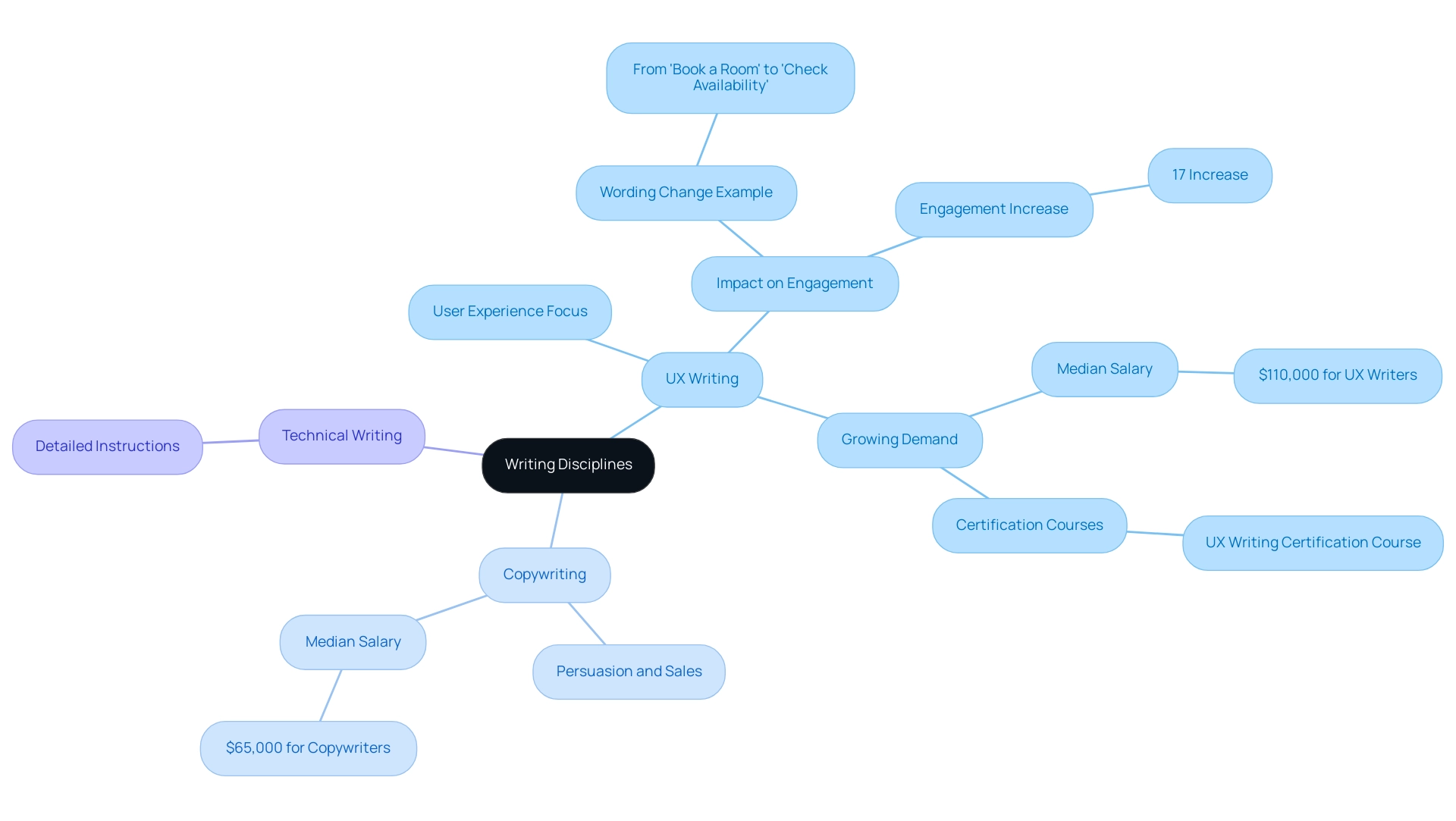
Fundamental Principles of Effective UX Writing: Clarity, Brevity, and Empathy
To grasp the essence of UX writing, one must acknowledge its foundation in three core principles: clarity, brevity, and empathy. Clarity is paramount; it ensures that users can easily comprehend the content without confusion, which is essential in a digital landscape inundated with information. Indeed, individuals face an overwhelming volume of content daily, resulting in skimming and scanning behaviors. Thus, it is imperative for UX creators to present information succinctly and straightforwardly.
Brevity complements clarity by sustaining audience attention and mitigating information overload. By eliminating superfluous details, writers can deliver concise messages that resonate with their audiences, thereby enhancing the overall user experience. The impact of clarity and brevity on engagement is profound; research shows that clear and succinct content correlates with higher retention rates and increased satisfaction.
Empathy serves as the third pillar of effective UX writing. It involves grasping the individual’s perspective and crafting messages that resonate with their needs and emotions. This compassionate approach not only fosters a connection with the audience but also encourages deeper interaction with the content.
For example, comprehensive campaigns designed for brands such as Miranda and Quaker Oats illustrate how empathetic messaging can enhance brand engagement and market presence, demonstrating measurable outcomes like improved audience interaction and brand loyalty.
As we look ahead to 2025, the significance of these principles remains clear. A/B testing in UX composition facilitates data-driven improvements based on real feedback from users, further enhancing effectiveness. By prioritizing clarity, brevity, and empathy, UX writers can create engaging content that informs and captivates users, elucidating the essence of UX writing and ultimately fostering a more favorable experience.
As Natasha Jafari aptly states, “we can WRITE as easily as we SPEAK!” This highlights the necessity for a conversational tone that resonates with users, reinforcing the principles of effective UX communication.
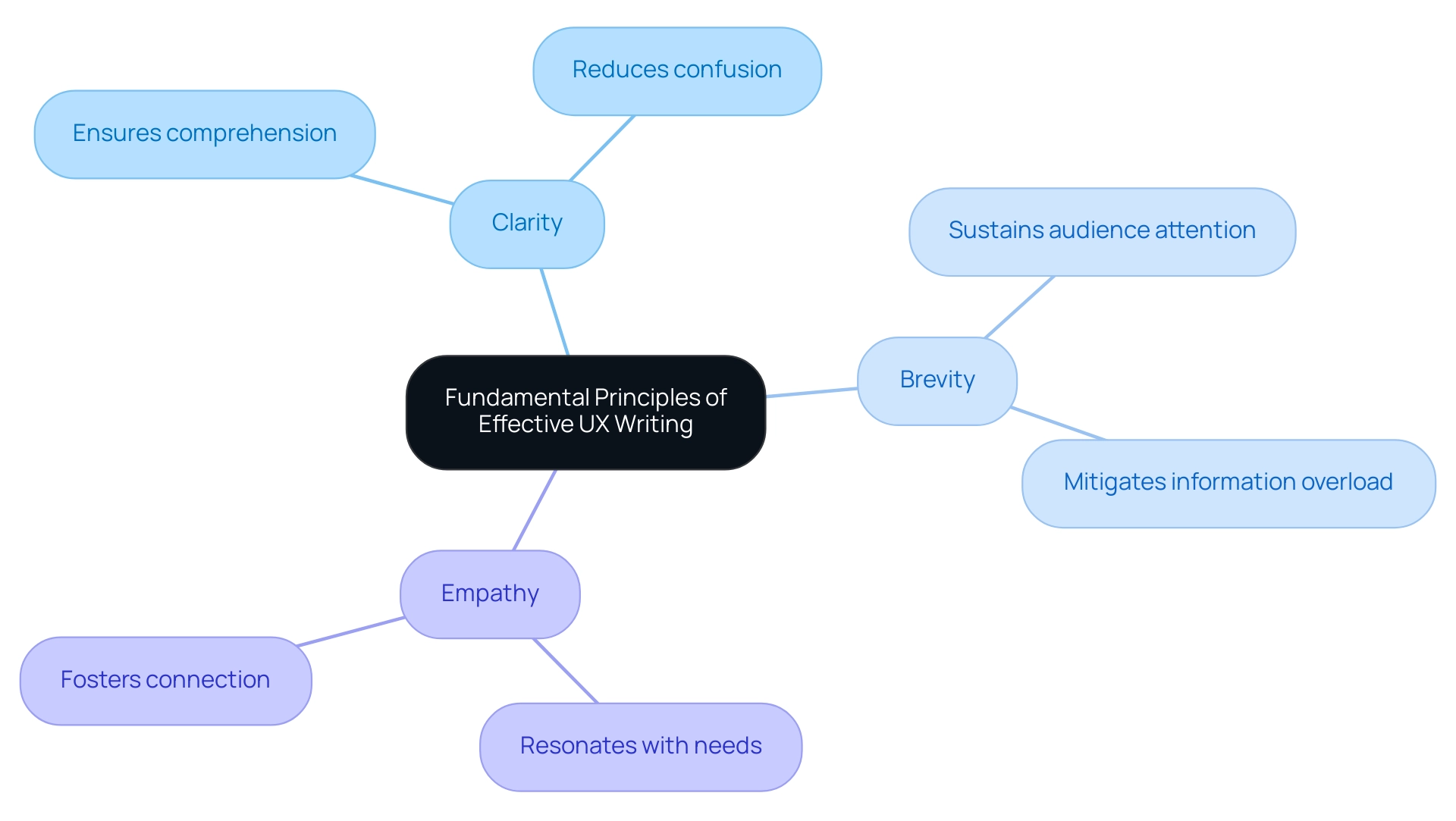
The UX Writing Process: From Research to Refinement
To comprehend what UX writing entails, one must recognize it as a dynamic and iterative journey comprising several essential steps:
- Understanding the project brief
- Conducting research on participants
- Ideating material
- Drafting
- Refining
Initially, UX authors engage with stakeholders to clarify the project’s goals and scope, ensuring alignment with business objectives. This foundational step is crucial, as 88% of visitors are unlikely to return to a site with poor visual design or slow load times, raising the question of how UX writing contributes to a visitor-centered approach.
Subsequently, UX authors delve into visitor research, gathering insights that inform their material creation. This phase is vital, as it clarifies the essence of UX writing, enabling writers to grasp the needs and preferences that significantly impact the effectiveness of the final product. The importance of audience feedback in defining UX writing cannot be overstated; it serves as a critical element in shaping material that resonates with the target group.
Indeed, 53.8% of web designers cite ‘not being responsive on all devices’ as a leading reason for website redesigns, underscoring the necessity of comprehensive audience research in the UX process.
Once the content is drafted, it undergoes testing with real individuals to collect feedback. This iterative process allows for essential adjustments, ensuring that the final output not only meets expectations but also enhances the overall experience. Notably, successful case studies, such as the comprehensive campaign for Quaker Oats, illustrate how innovative branding and digital marketing techniques can yield significant improvements in brand recognition and customer loyalty.
Furthermore, the brand identity enhancement for Castania and the digital campaign for Motorola showcase the measurable results achieved through effective UX communication and branding strategies.
Best practices in UX communication elucidate what UX writing is by emphasizing the importance of ongoing improvement based on feedback from individuals and industry standards. As the landscape evolves, expert opinions suggest that while AI will enhance the capabilities of UX designers, it cannot replicate the human empathy and creativity essential for understanding client needs. This highlights the enduring significance of human insight in the UX creation process.
In summary, grasping what UX writing is essential, as the UX creation process is not a linear path but rather a cycle of research, feedback, and refinement that ultimately leads to more effective digital products. By adhering to these principles, UX writers can craft content that not only engages individuals but also drives measurable outcomes.
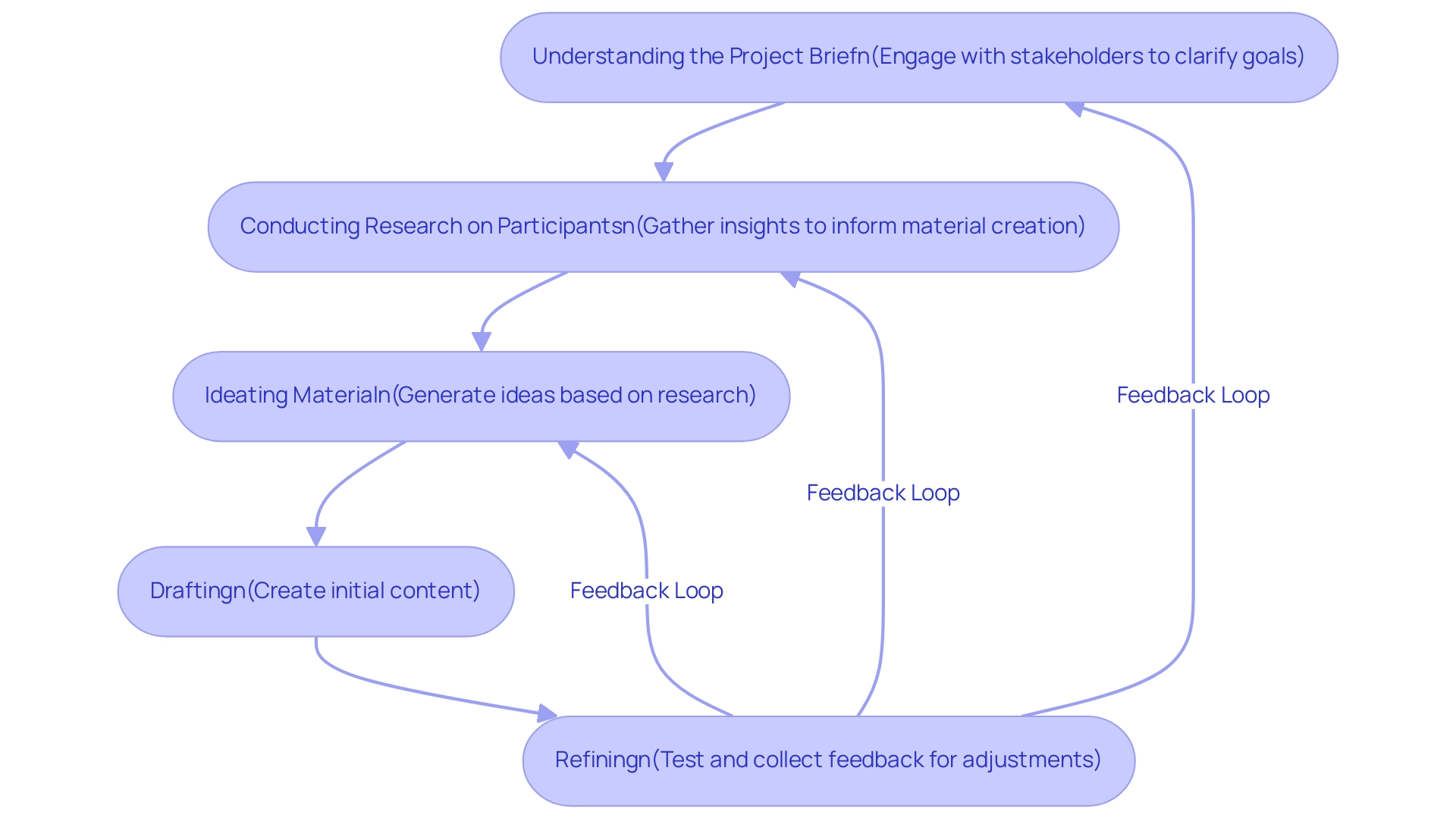
Best Practices for UX Writing: Tips for Engaging and Effective Content
Optimal strategies for UX writing emphasize the use of clear language, consistency in tone and style, and a strong focus on user needs. Writers must avoid jargon and complex terminology that could confuse readers, opting instead for straightforward language that enhances understanding. Adopting a conversational tone can further enhance relatability, making the material more engaging for individuals.
Developing a comprehensive content style guide is essential for maintaining consistency across all interaction touchpoints. This guide should outline preferred terminology, tone, and formatting to ensure a cohesive experience. Regular testing and iteration based on participant feedback are vital for continuous improvement and engagement.
In fact, personalizing push notifications has been shown to increase reaction rates by up to 400%, highlighting the impact of tailored communication.
Incorporating effective error messages is another critical aspect of UX writing. These messages should guide individuals through mistakes and misunderstandings, thereby enhancing overall usability. By weaving clarity, empathy, and guidance into every screen, button, and message from the outset, writers can significantly improve UX writing and user experience.
As Kateryna Mayka, a Senior Content Creator at Eleken UI/UX design agency, states, “If there’s one key takeaway about UX writing, it’s this: UX text isn’t an afterthought.” It’s not about sprinkling in words at the end of the design process. It’s about weaving clarity, empathy, and guidance into every screen, button, and message — right from the start.
Furthermore, examining successful case studies, such as the comprehensive campaigns executed for brands like Mirinda and Quaker Oats, illustrates how engaging content can resonate with target audiences and foster brand loyalty. These examples highlight the significance of creating UX content that not only informs but also engages individuals on a deeper level. WonderEight distinguishes itself by merging creativity with technology, ensuring that each project is not only visually appealing but also strategically sound, which is essential in the realm of effective UX.
The Future of UX Writing: Trends and Evolving Roles in Digital Design
The future of UX communication is poised for transformative changes, significantly influenced by technological advancements and evolving user expectations. Key trends shaping this landscape include the integration of artificial intelligence in content creation, revolutionizing how authors approach their craft. As AI tools advance, UX professionals must adapt their strategies to leverage these technologies effectively, ensuring their content remains user-centered and impactful.
Voice interfaces are gaining momentum, prompting UX professionals to develop material that is not only engaging but also optimized for auditory experiences. This shift necessitates a profound understanding of conversational design and the nuances of spoken language, thereby expanding the skill set required for modern UX writing, particularly in grasping the essence of what constitutes UX writing.
Accessibility remains a critical focus area, as businesses increasingly acknowledge the importance of inclusive design. UX authors will play a pivotal role in crafting content that is accessible to all individuals, ensuring that digital experiences cater to diverse groups.
As the responsibilities of UX professionals evolve, collaboration with designers and developers will become increasingly integral. This teamwork will cultivate the creation of cohesive and engaging experiences, where every element—from text to visual design—works harmoniously to guide individuals effectively.
Looking ahead to 2025 and beyond, expert predictions indicate that the role of UX writers will continue to expand, leading to discussions about what defines UX writing, with a heightened emphasis on data-driven decision-making. The capacity to analyze user feedback and metrics will be essential in refining content strategies and enhancing overall user satisfaction. Notably, improvements in UX design can boost customer retention by a mere 5%, which can translate into a 25% increase in profit, underscoring the significance of effective UX communication in driving business outcomes.
Moreover, case studies from leading agencies, such as the comprehensive campaigns developed for brands like Miranda and Quaker Oats, illustrate how effective UX writing can significantly enhance brand experiences and drive consumer engagement. These campaigns highlight the evolving responsibilities of UX professionals, demonstrating how their contributions were vital to the success of these initiatives.
In this rapidly evolving field, understanding the essence of UX writing and embracing new tools and methodologies will be crucial for UX writers to remain relevant and effective in delivering exceptional user experiences. As Kate Moran aptly states, “Accept it, be open to it, and (even) pursue it.” This mindset will be essential for adapting to the changes in UX writing.
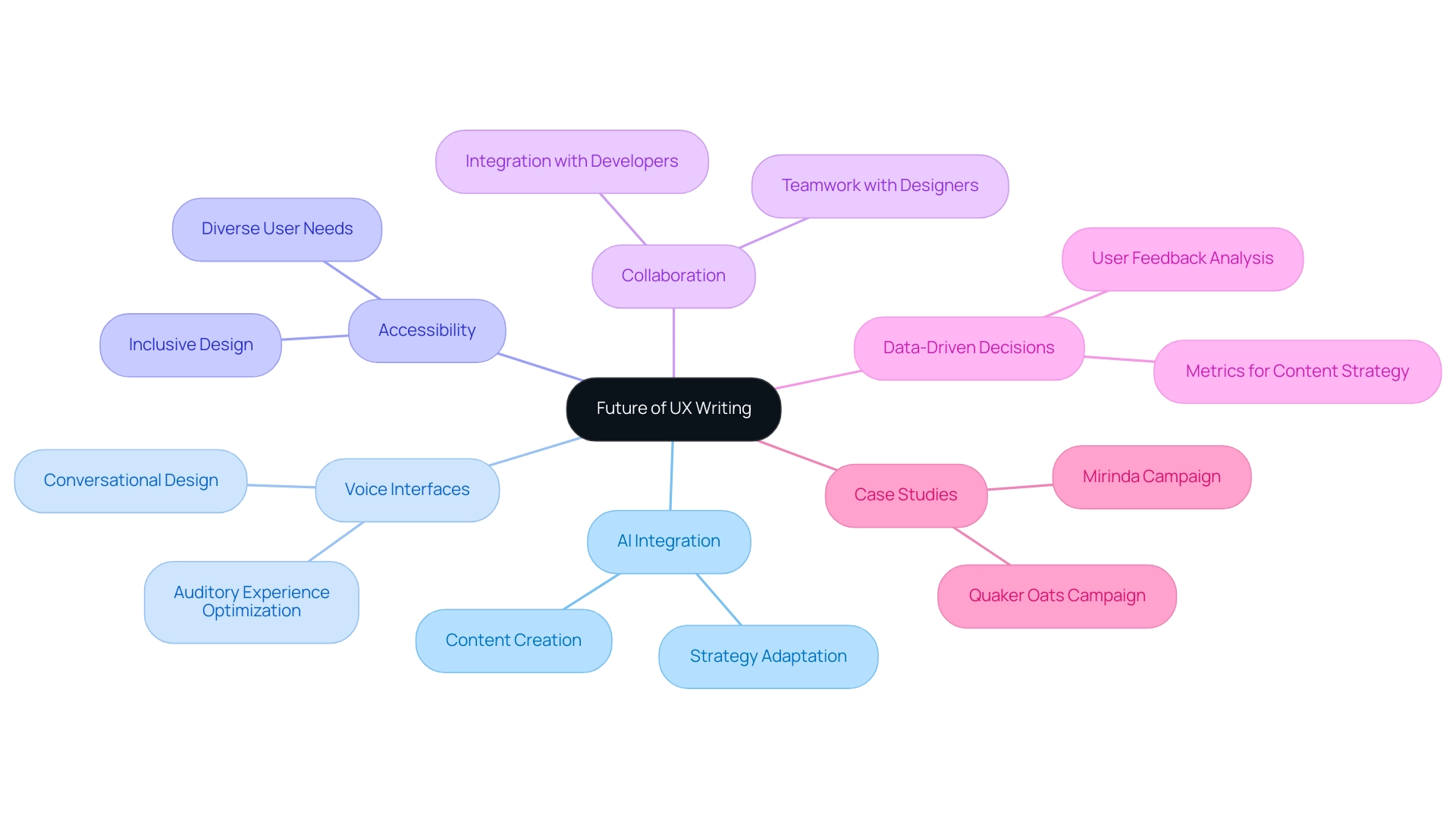
Conclusion
The significance of UX writing in the digital landscape is paramount. It serves as the backbone of user interaction, ensuring that every piece of text enhances clarity, guides users effectively, and fosters engagement. By focusing on key principles such as clarity, brevity, and empathy, UX writers play a pivotal role in creating seamless experiences that resonate with users. As evidenced by compelling statistics and case studies, effective UX writing not only contributes to user satisfaction but also drives brand loyalty and business success.
Looking ahead, the evolving nature of technology and user expectations will continue to shape the role of UX writers. With trends like artificial intelligence and voice user interfaces on the rise, writers must adapt and expand their skill sets to meet the demands of modern digital communication. Collaboration with other design disciplines will be essential, reinforcing the idea that UX writing is not an afterthought but a fundamental component of the design process.
In summary, as organizations increasingly recognize the importance of user-centric design, the demand for skilled UX writers will grow. Investing in effective UX writing is not just about improving user experience; it is a strategic move that can lead to substantial financial returns and a stronger market presence. Embracing this discipline is crucial for businesses aiming to thrive in a competitive digital landscape, making the role of UX writers more vital than ever.
Frequently Asked Questions
What is UX writing and why is it important?
UX writing is a discipline focused on creating text that users encounter while interacting with digital products, such as websites and applications. It aims to enhance user experience by ensuring that the language is clear, concise, and tailored to user needs, which is crucial for guiding users and improving their overall satisfaction.
What are some key elements included in UX writing?
Key elements of UX writing include button labels, error messages, onboarding instructions, and help content. These components are essential for facilitating user interaction and improving usability.
What trends are shaping UX writing in 2025?
In 2025, trends in UX writing emphasize personalization and context-awareness. Customizing communications, such as push notifications, can significantly boost user engagement, underscoring the importance of tailored interactions.
How does poor UX affect user retention?
Statistics indicate that 88% of users are less likely to return to a site after experiencing poor UX, while 91% of dissatisfied customers leave without providing feedback. This highlights the critical need for effective UX design to retain users.
What are the financial benefits of investing in UX design?
Investing in UX design can lead to long-term savings by minimizing the need for costly redesigns and reducing customer attrition. Research shows that every dollar spent on customer experience can generate an average return of 100 dollars.
What are the fundamental concepts of UX writing?
The fundamental concepts of UX writing include clarity, brevity, and user-centricity. These principles guide UX writers in creating content that enhances user experience and satisfaction.
How does a UX author contribute to digital product design?
A UX author collaborates closely with designers, product managers, and developers to create and refine textual content that aligns with design goals. Their role involves understanding audience needs and crafting messages that resonate effectively with users.
What impact does effective UX writing have on conversion rates?
Effective UX writing can significantly enhance product usability, leading to increased conversion rates. Research indicates that proficient UX can double conversion rates, demonstrating the tangible benefits of skilled UX writing in product design.
How do successful UX communication strategies influence brand engagement?
Successful UX communication strategies, such as clear messaging and intuitive navigation, have a direct impact on brand engagement, as evidenced by case studies where effective UX communication elevated brand presence and fostered consumer loyalty.
Why is understanding audience behavior important in UX writing?
Understanding audience behavior and preferences is crucial for designing effective and engaging experiences. This insight helps UX writers create content that resonates with users, ultimately enhancing satisfaction and driving business success.



